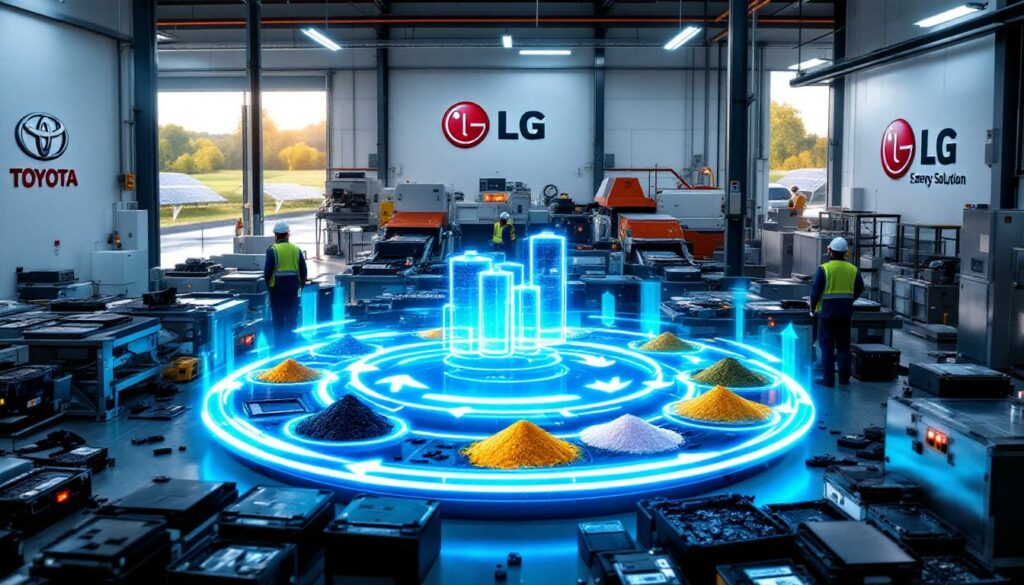The Green Revolution: LG Energy Solution and Toyota Partner on EV Battery Recycling
In a significant move toward sustainable battery production, LG Energy Solution (LGES) and Toyota Tsusho have joined forces to establish a pioneering battery recycling venture in the United States. This strategic partnership, announced in mid-2025, represents a major step toward creating a circular economy for electric vehicle batteries while addressing critical supply chain challenges.
The Birth of Green Metals Battery Innovations
The joint venture, aptly named Green Metals Battery Innovations, aims to establish comprehensive battery recycling operations on American soil. This collaboration between two industry giants combines Toyota's automotive expertise with LG Energy Solution's battery manufacturing prowess to create a closed-loop system for recovering valuable materials from used batteries and production scrap.
Rather than exporting battery waste overseas, this partnership will establish regional recycling infrastructure, enabling materials to be reprocessed and reused within North America. The initiative aligns perfectly with both companies' sustainability goals while addressing growing concerns about battery metals investment and environmental impact.
"This joint venture will not only help secure a stable supply of key battery materials but also enhance the competitiveness of our recycling business in North America. We are fully committed to leading the recycling market through innovative and differentiated technologies." – Chang Beom Kang, CSO of LG Energy Solution
The partnership builds upon existing collaboration between the companies, as LGES is already slated to supply Toyota with 20 gigawatt-hours of battery modules annually beginning in 2025, featuring advanced NCMA pouch cells with high nickel content.
North Carolina's Cutting-Edge Recycling Facility
The centerpiece of this partnership will be a state-of-the-art recycling facility located in North Carolina, strategically positioned to support the growing EV manufacturing ecosystem in the southeastern United States.
Impressive Capacity and Timeline
The North Carolina facility is scheduled to begin operations in 2026 with impressive specifications:
- Processing capacity: 13,500 tons of battery scrap annually
- Battery equivalent: Approximately 40,000 electric vehicle batteries
- Initial feedstock: Production scrap from LGES's EV battery manufacturing for Toyota
- Future sources: End-of-life batteries as they become available
This substantial capacity positions the facility as a significant player in North America's emerging battery recycling landscape, capable of handling a meaningful portion of the region's battery waste.
Advanced Pre-Processing Technology
The facility will employ sophisticated pre-processing technology designed to recover "black mass" – the valuable mixture of metals and compounds that remains after batteries are crushed and processed. This critical first step in battery recycling:
- Safely discharges and disassembles battery packs
- Crushes and processes cells to extract cathode and anode materials
- Recovers black mass containing lithium, nickel, cobalt, and manganese
- Prepares materials for further refining and reuse
Initially, the plant will focus on processing production scrap from LGES's manufacturing operations for Toyota, which provides a predictable and consistent material stream. As more EVs reach end-of-life, the facility can transition to processing a greater percentage of used batteries.
The Strategic Importance of Battery Recycling
As electric vehicles gain mainstream adoption, the ability to recycle their batteries has evolved from an environmental nicety to a strategic imperative.
Securing the Supply Chain
Battery recycling offers several critical advantages for supply chain security:
- Reduced import dependence: Decreases reliance on foreign suppliers for critical battery materials
- Regional resilience: Creates material loops within North America, minimizing global transport risks
- National security: Addresses growing concerns about battery materials as strategic resources
- Geopolitical insulation: Reduces exposure to international trade disputes and shipping disruptions
These benefits have become increasingly important as governments worldwide recognize battery materials as essential to critical minerals energy transition strategies. The Biden Administration's Inflation Reduction Act specifically incentivizes domestic battery production and material sourcing, making recycling initiatives like this particularly timely.
Environmental and Sustainability Benefits
Beyond supply chain considerations, battery recycling delivers substantial environmental benefits:
- Circular economy: Establishes true battery-to-battery material flows
- Reduced mining impact: Decreases the need for new raw material extraction
- Lower carbon footprint: Toyota's February 2025 battery recycling breakthrough claimed a 20% CO₂ reduction compared to mining
- Waste reduction: Prevents potentially hazardous materials from entering landfills
- Energy conservation: Requires significantly less energy than primary material production
These environmental advantages align with both companies' sustainability commitments and respond to growing consumer demand for responsibly produced EVs with smaller ecological footprints.
Navigating Battery Recycling Challenges
Despite its promise, battery recycling faces several significant hurdles that this partnership must address to succeed.
The Battery Lifecycle Timing Puzzle
One of the industry's most persistent challenges is the extended lifecycle of EV batteries:
- Primary automotive use: Typically 9-10 years in vehicles
- Secondary applications: Often repurposed for stationary storage for up to an additional 10 years
- Total lifecycle: Can reach nearly 20 years before recycling
This extended timeline creates a "recycling gap" – manufacturers need recycled materials now, but most EV batteries sold today won't be available for recycling until the mid-2030s. Currently, recycling operations rely heavily on:
- Production scrap (approximately 70% of current feedstock)
- Warranty returns and damaged batteries
- Unsold or unused battery inventory (about 30% of current recycling volume)
Industry analysts project that end-of-life EV batteries won't become the dominant recycling source until around 2035, creating interim supply challenges.
Technical and Infrastructure Complexities
Battery recycling involves a complex two-stage process that presents significant technical challenges:
- Pre-processing: Converting batteries to black mass through mechanical and chemical processes
- Post-processing: Refining black mass into battery-grade materials through hydrometallurgical or pyrometallurgical methods
Currently, while pre-processing capacity is growing in North America, post-processing remains heavily concentrated in Asia, with China controlling approximately 80% of global capacity. This creates a situation where:
- Black mass must often be shipped overseas for final processing
- Complete end-to-end recycling infrastructure doesn't yet exist in North America
- Technical expertise and equipment remain limited outside Asia
The LGES-Toyota partnership addresses the first stage of this process but highlights the need for complementary investments in post-processing capacity to complete the circular material loop within North America.
Aligning with Broader Industry Trends
This partnership doesn't exist in isolation but reflects and reinforces several important industry-wide developments.
Global Battery Recycling Momentum
Major automotive and battery manufacturers are rapidly scaling up recycling capabilities:
- Toyota's February 2025 announcement: New recycling technology promising improved CO₂ reduction
- Toyota's U.S. partnerships: Previous collaborations with Cirba Solutions (2023) and Redwood Materials (2022)
- CATL collaboration: Ongoing recycling activities with Toyota since 2019
- EU regulatory pressure: Increasingly stringent recycling requirements driving industry innovation globally
These parallel efforts highlight how battery recycling has transformed from a niche environmental concern to a core business strategy for industry leaders.
Vertical Integration as Competitive Strategy
The LGES-Toyota partnership exemplifies the industry-wide trend toward vertical integration across the battery value chain:
- Production coordination: LGES will supply 20 GWh of battery modules to Toyota annually from 2025
- Material alignment: LG Chem is supplying cathode materials to Toyota's North Carolina plant
- Technology synchronization: Battery designs and recycling processes being optimized together
- End-to-end planning: Coordinated production and recycling operations enhance efficiency
This holistic approach enables tighter quality control, more efficient material usage, and better lifecycle planning than disconnected production and recycling operations could achieve.
Significance for the EV Industry and Beyond
The implications of this partnership extend far beyond the companies directly involved, potentially reshaping the broader EV ecosystem.
Economic Ripple Effects
The establishment of this recycling facility insights promises significant economic benefits:
- Job creation: New green economy positions in manufacturing, engineering, and technical roles
- Regional economic development: Strengthening North Carolina's position as an EV manufacturing hub
- Cost stabilization: Potential long-term moderation of battery material price volatility
- Competitive advantage: Enhanced North American positioning in the global battery market
As recycling operations scale, they could help address one of the EV industry's persistent challenges – the high cost of batteries – by providing a more stable and potentially less expensive material source.
Technological Innovation Catalyst
The partnership will likely drive forward several important technological developments:
- Recycling process optimization: Improving efficiency and yield of material recovery
- Battery design evolution: Facilitating "design for recycling" principles in future batteries
- Technical expertise development: Building specialized knowledge and skill sets in North America
- Infrastructure advancement: Creating templates for future recycling facilities
These technological advances could accelerate the broader transition to more sustainable transportation by making EVs both more affordable and environmentally sound.
FAQ: LG Energy Solution and Toyota Battery Recycling Partnership
What materials will be recovered from recycled batteries?
The recycling process will focus on extracting valuable materials including lithium, nickel, cobalt, and manganese from used batteries and production scrap, which can then be reintroduced into new battery production.
How does battery recycling compare to mining for new materials?
Battery recycling typically produces significantly lower carbon emissions compared to mining raw materials, while also eliminating the environmental disruption associated with extraction activities and reducing water usage.
Will this partnership affect battery prices for consumers?
As recycling operations scale up and become more efficient, the recovered materials could help stabilize battery material costs, potentially contributing to more affordable electric vehicles in the long term.
How does this partnership address the Inflation Reduction Act requirements?
This recycling initiative supports domestic content requirements under the IRA by increasing the percentage of battery materials sourced within North America, potentially helping manufacturers qualify for tax credits.
| Comparison of Regional Battery Recycling Approaches |
|——————————————————–|—————————————————–|
| North America | Emerging pre-processing capacity, limited post-processing, government incentives |
| European Union | Strong regulatory framework, mandatory recycling targets, developing infrastructure |
| Asia | Established end-to-end recycling capacity, dominated by China, integrated with manufacturing |
Industry Expert Insight:
"This joint venture will not only help secure a stable supply of key battery materials but also enhance the competitiveness of our recycling business in North America. We are fully committed to leading the recycling market through innovative and differentiated technologies." – Chang Beom Kang, CSO of LG Energy Solution
Further Exploration:
Readers interested in learning more about battery recycling initiatives can also explore related educational content available at LG Energy Solution's corporate website.
The Road Ahead: Challenges and Opportunities
While the LGES-Toyota partnership represents a significant step forward, the path to a fully circular battery economy still faces obstacles.
Scaling to Meet Future Demand
As millions of EVs hit roads worldwide, recycling infrastructure must expand dramatically:
- Volume projections: By 2035, over 12 million EV batteries annually could reach end-of-life globally
- Infrastructure gap: Current recycling capacity represents less than 30% of projected needs
- Geographic distribution: Facilities must be strategically located to minimize transport costs
- Technology evolution: Recycling processes must adapt to changing battery chemistries
The North Carolina facility, while substantial, represents just one piece of the much larger recycling ecosystem that will ultimately be required.
Policy and Standardization Needs
The recycling industry would benefit from several policy and standardization developments:
- Battery passports: Digital records tracking battery materials and history
- Design standards: Industry-wide agreements on battery designs that facilitate recycling
- Collection infrastructure: Systems for gathering end-of-life batteries efficiently
- Regulatory harmonization: Consistent rules across jurisdictions to enable economies of scale
These developments would complement private-sector investments like the LGES-Toyota partnership, creating a more efficient overall system. Additionally, the EV impact on mining continues to drive innovation in sustainable practices throughout the supply chain.
Disclaimer: This article contains forward-looking statements regarding market trends, technological developments, and business outcomes. Actual results may vary based on numerous factors including technological advancements, regulatory changes, and market conditions.
Ready to Stay Ahead of Critical Mineral Discoveries?
Gain immediate insights into significant ASX mineral discoveries and investment opportunities with Discovery Alert's proprietary Discovery IQ model, transforming complex market data into actionable intelligence. Visit the Discovery Alert discoveries page to see why historic mineral discoveries can generate substantial returns and start your 30-day free trial today.




